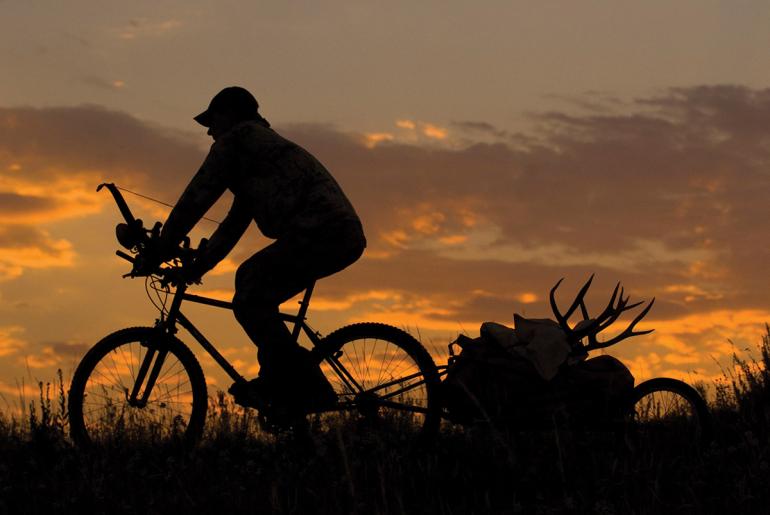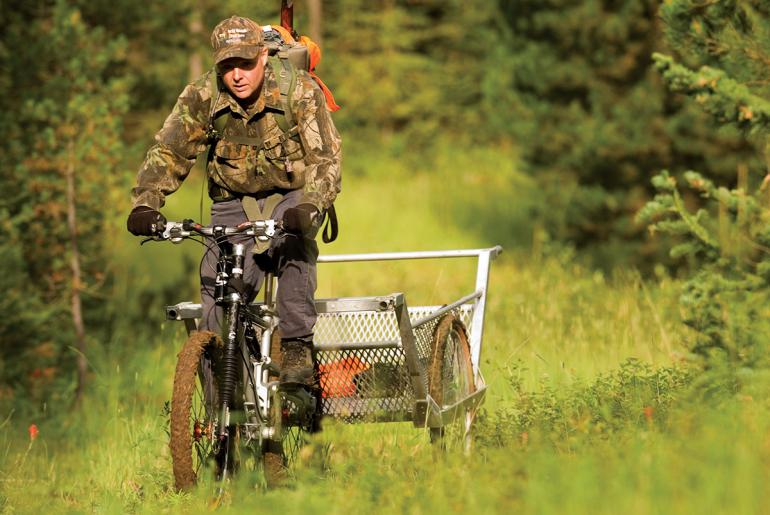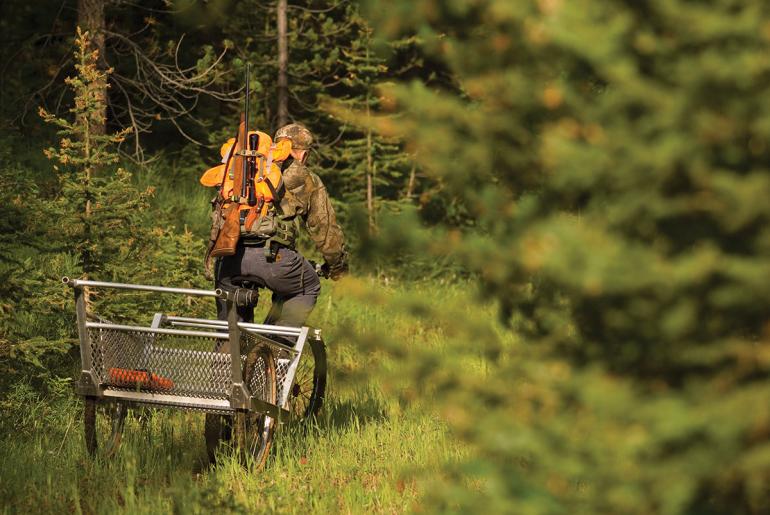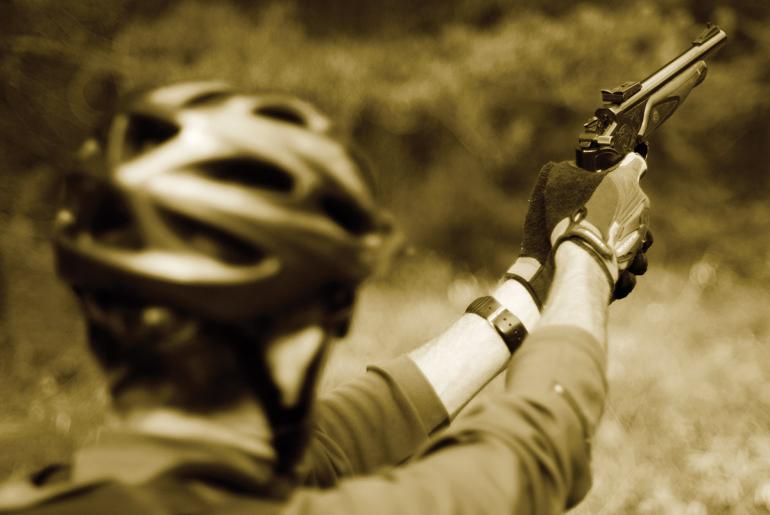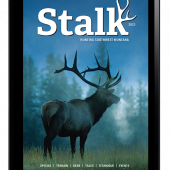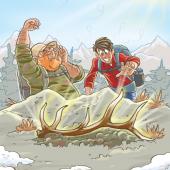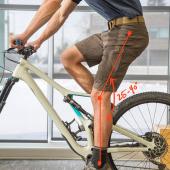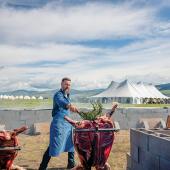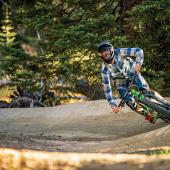Have Bike, Will Hunt
Chasing game on two wheels.
The cycling days in the mountains around Bozeman are numbered. Sandwiched between June’s mud season and the first snows, there never seems to be enough of those fat-tire days in the high country. The advent of shorter days and cooler temperatures activate the red and yellow foliage of autumn, signaling the celebration of the harvest and the commencement of the hunt.
Being avid hunters, we previously were in a quandary about how to divide our time between our craving for wild game and our passion for mountain biking on those precious September days. We eventually discovered that with the right gear and choice of location, we could seize the last sweet days of riding and compatibly incorporate opportunities to hunt. Hanging onto our bicycling passion for as long as the conditions permit, we hunt using mountain bikes until the double tracks are impassable or the hunting season ends. Bike hunting is the payoff for long summer days in the saddle spent strengthening muscles, encountering wildlife, and orienting ourselves to a herd’s migratory habits.
On this beautiful Indian summer day we cycle farther away from the gates closed to motorized traffic and climb deeper into the backcountry. Spinning in a small chain ring, we round a bend in the trail below the jagged ridgeline of the Gallatin Range and stop to catch our breath and reflect for a moment on the inspiring alpine panorama of the Hyalite drainage. Far below to the north, with a backdrop of the Bridger Mountains, the Gallatin Valley’s green landscaped residential developments intermingle with the golden grain farmlands. Meandering rows of majestic cottonwoods bisect the countryside like tiny contour map lines, which shield the river and irrigation ditches from sight.
In the midst of upland bird season we’re killing two birds with one stone, so to speak. Scouting in this vast remote public land of the Hyalite Big Horn Porcupine Wilderness Study Area for opening day of big game hunting, my favorite trails crisscross habitat secluded beneath the rocky peaks that mule deer and elk will frequent later in the season. The future possibility that this traditional hunting ground may be closed to mountain bikes challenges my focus and breaks the solitude.
Erasing thoughts of public land access politics, I follow my partner Bob as he drops over the rocky saddle away from the breathtaking skyline, body and bike zigzagging through the rolling terrain of the forested single track. Traveling with compact cycling packs partially filled with water, game bags, licenses, pistol, and ammo, we fly through the light and shadow in the trees. Slowing the bikes to explore a thick patch of snowberries, my hunting partner and I spot fresh signs of deer traffic and flush a feeding blue grouse. Bonus—we found what we came to hunt on this day: mountain grouse.
Stashing our bikes, we look for more signs of the comical birds that all summer long have appeared abruptly on the trail in direct line of our bikes whenever we were single-tracking through their neighborhood, only to dart into the brush at the last moment unharmed. Somehow they knew it wasn’t hunting season. Now the time is right and the predator in me is unleashed: go ahead, bird, and make my day.
Stealthily perched, the startled grouse is silhouetted in the tree limb of a lone Douglas Fir a short distance away. We spy another bobbing head in the colorful foliage nearby. Transitioning from recreating cyclists to focused hunters with heightened senses, we open our packs, pull out the pistols, and drop .410 shotgun shells into single-shot Thompsons.
Firearm raised and taking aim, Bob approaches a grounded bird with anticipation of its final self-preserving flight. Stillness persists until the grouse explodes skyward with loud flaps and accelerates down the drainage. Tracking the bird, he fires a shot, ending its life while I remain vigilant for the movement of other birds as the forest absorbs the concussion. The first birds of our daily limit in the bag, with others to follow, we continue to ride and hunt. Arriving back at the trailhead with spent legs and full packs, the birds will be dressed tonight for future dining and this evening we’ll feast on roasted grouse with a sauce made from wild berries.
Bike hunting began as a personal choice to be environmentally conscious, self-powered, and sagacious while hunting in the backcountry. The primary advantage for incorporating a bike into the hunt is to access public lands swiftly via logging roads beyond gates closed to specific motorized vehicles and to enter the hunting zone quietly. A hard day’s hike through the woods in search of elusive prey is a guarantee when pursuing big game, but pulling the trigger is made easier when you know that biker ingenuity is parked just around the corner to assist with the transport of the field-dressed meat. After a big-game success, with knobby tires, the bike hunter pulling a game cart or trailer can give gravity the wheels to extract the heavy load from the forest efficiently, ready for packaging and storage in the freezer. Likewise, two bikes strapped together make a simple and effective travois for hauling out the biggest game in one trip; that’s one good reason to bring along an adventurous partner. Easier still, bird hunting with a mountain bike makes for a lightweight outing, and the weight of a full bird pack nary burdens the ride.
A final bit of advice: Field-dressed meat does not preclude tagging your animal for clear identification; you must bring an antler out and a part of the animal to identify its sex. Remember to respect the animal whose life will nourish yours, and take all the meat with you.
Rigging Your Bike for the Hunt
BICYCLE BASICS
A bike can be as much a part of the hunting experience as you want. Your hunting rig doesn’t need to be the latest and greatest but the bike does need to be well-tuned and set up to handle a heavy load. Large-platform BMX-style flat pedals offer the best support and grip for your preferred hiking boots; pack a pair of gators to keep your lower extremities dry on the long, wet trek. Appropriately inflated heavy-duty tubes and tires will help eliminate pinch flats and will perform better.
RIDING WITH WEAPONS
Whether using a bow, pistol, shotgun, or rifle, a secure method of carrying the piece is vital. Handlebar-mounted brackets or rear-mounted scabbards are available for both bows and rifles. Attaching a bow or rifle to a backpack insulates it from trail shock but can catch on overhead branches. Don’t ride with a loaded firearm; it is bad form to negligently shoot yourself or your hunting partner.
MINDING THE MEAT
Proper care with the meat is the top priority after pulling the trigger. Knowledge of field dressing and having a plan for transporting the meat before the kill are a must. Evenly distributed, a bike can handle in excess of one hundred pounds of game plus gear with the muscle power of a physically fit hunter; even more if a trailer or game cart is used. A large-volume backpack and front and rear racks with large panniers can be used to spread the weight. If boning out the animal, transporting the meat in plastic trash bags will keep it clean. Light but strong game sacks can be can be tied to bike racks, hung over top tubes, or strapped to a pack.
PREPARING FOR THE UNKNOWNS
Be sure to bring basic bike tools and an extra tube, patch kit, and tire pump. In addition to the appropriate licenses, map, and ammunition, a minimal hunting kit should contain water, food, a sharp knife, folding saw, rope, compass, whistle, extra base layer and clothing, plastic bags, matches, and a headlamp with spare batteries. Always let someone know where you’ve gone and when you expect to return.
PRACTICE RIDING
Whatever method used to carry out the game, do a practice run with your pack or trailer loaded. Rolling downhill in the dark with a load of venison is not the time to discover that your brakes suck, your rack is broken, or your pack doesn’t fit you correctly.
Land Access: How to Keep Public Trails Open to Bikers
Mountain bikers are challenged to take their pedal-powered, non-fossil-fueled wheels to every public meeting regarding the Gallatin National Forest. At stake: a lawsuit against the Forest Service that threatens to close bicycling on the Gallatin Crest Trail (GCT) and in the upper Hyalite drainage. This scenic alpine trail system, nestled among 155,000 stunning acres in that Gallatin Range called the Hyalite Porcupine Big Horn Wilderness Study Area (HPBH WSA), originates at the head of Hyalite Canyon and stretches to the northern boundary of Yellowstone National Park.
Trails within the upper Hyalite drainage, including Mount Blackmore, Emerald Lake, and Hyalite Lake trails, are located within the contested wildernesss study area too. With other trailheads near Big Sky and throughout the Gallatin Canyon, arriving at GCT is still physically demanding, ensuring that there will never be front-country human congestion, if commercial permits are well-managed. The HPBH WSA naturally selects its users, regardless of the non-motorized mode of recreating, including bikes.
Abundant information exists regarding bicycles' low impact on trails, other recreationalists, and wildlife; undeniably mountain biking and bike hunting are appropriate backcountry activities. Just ask Corey Biggers. Unsportingly allergic to horses, Corey is an expert mountain biker who in the 80s began big-game hunting by cycling in the highlands alongside his family and friends, all hunters on horseback. A native Montanan and longtime mountain-bike advocate, Biggers shares the trails and knows firsthand that bikes are compatible with hikers and horses. “We need to preserve mountain biking trails in special places,” he explains. “With all the wilderness acreage that local bikers can’t access already, if [non-bikers] can’t find serenity in a few million acres now, closing the Crest Trail and 155,000 more acres isn’t going to make a difference. I suggest those folks simply go across the road to the [Lee] Metcalf Wilderness.”
How to keep trails open to bikes? According to Greg Beardslee, co-founder of the Gallatin Ridge Riders and an avid mountain biker, “we need every mountain biker to weigh in on the public process. We have proven ourselves as a responsible user group who values wilderness. It’s time to get informed on the potential trail closures and report on our sweat equity as land stewards who have maintained and improved sustainable trail systems.
Multiple land protection designations, a toolbox created by Congress, can be recommended by the Forest Service to preserve wilderness and protect important areas for bicycling. Write your local, state and federal elected officials; attend informational meetings, and share your views on the potential trail closures, pronto. Also, volunteer on National Public Lands Day in September; don’t ride on vulnerable trails; spread the word to other cyclists; and when biking, always use good etiquette. Every backcountry visitor can promote the value so eloquently stated by Corinne Roosevelt Robinson, younger sister of President Theodore Roosevelt: “On the path that leads to Nowhere I have sometimes found my Soul.” If I may add, we can find it whether we go there by bike, by ski, by foot, or by horse.
Cruise these websites for beta:
• imba.com
• bozemanbiketalk.com/forum
• fs.fed.us/r1/gallatin


